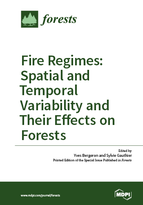Fire Regimes: Spatial and Temporal Variability and Their Effects on Forests
A special issue of Forests (ISSN 1999-4907).
Deadline for manuscript submissions: closed (31 July 2016) | Viewed by 156696
Special Issue Editors
2. Département des sciences biologiques, Université du Québec à Montréal, Montreal, QC, Canada
Interests: ecosystem forest management; fire; disturbance ecology; climate change
Special Issues, Collections and Topics in MDPI journals
Special Issue Information
Dear Colleagues,
Fire regimes (occurrence, cycle, severity, size, etc.) are key factors in many forest ecosystems, as they are often critical drivers of forest composition, dynamics, and ecosystem processes. Fire regimes vary in space and time according to climatic, physical and biological factors. A better understanding of the interacting factors controlling fire regime may contribute to improving fire and forest management and their future projection in the context of global change. Knowledge of fire regimes effects on natural landscapes is also used in forestry as a template to manage the forest for wood production. This approach, by keeping biodiversity and ecological processes associated with natural fire regime, may also help in maintaining forest productivity and resilience in the face of climate change. This Special Issue aims to synthesize current understanding of factors affecting fire regime characteristics, to present recent research on fire regimes and their effects on forest ecosystems, and to illustrate how this knowledge could be translated into forest or fire management strategies in the context of global change.
Submitted manuscripts must be original contributions, not ones previously published or submitted to other journals. Papers published or submitted for publication in conference proceedings may be considered, provided that they are considerably extended and improved.
Prof. Dr. Yves Bergeron
Dr. Sylvie Gauthier
Guest Editors
Manuscript Submission Information
Manuscripts should be submitted online at www.mdpi.com by registering and logging in to this website. Once you are registered, click here to go to the submission form. Manuscripts can be submitted until the deadline. All submissions that pass pre-check are peer-reviewed. Accepted papers will be published continuously in the journal (as soon as accepted) and will be listed together on the special issue website. Research articles, review articles as well as short communications are invited. For planned papers, a title and short abstract (about 100 words) can be sent to the Editorial Office for announcement on this website.
Submitted manuscripts should not have been published previously, nor be under consideration for publication elsewhere (except conference proceedings papers). All manuscripts are thoroughly refereed through a single-blind peer-review process. A guide for authors and other relevant information for submission of manuscripts is available on the Instructions for Authors page. Forests is an international peer-reviewed open access monthly journal published by MDPI.
Please visit the Instructions for Authors page before submitting a manuscript. The Article Processing Charge (APC) for publication in this open access journal is 2600 CHF (Swiss Francs). Submitted papers should be well formatted and use good English. Authors may use MDPI's English editing service prior to publication or during author revisions.
Keywords
- Fire regime
- Wildfire
- Natural disturbances
- Forest ecosystems
- Forest management
- Global change






